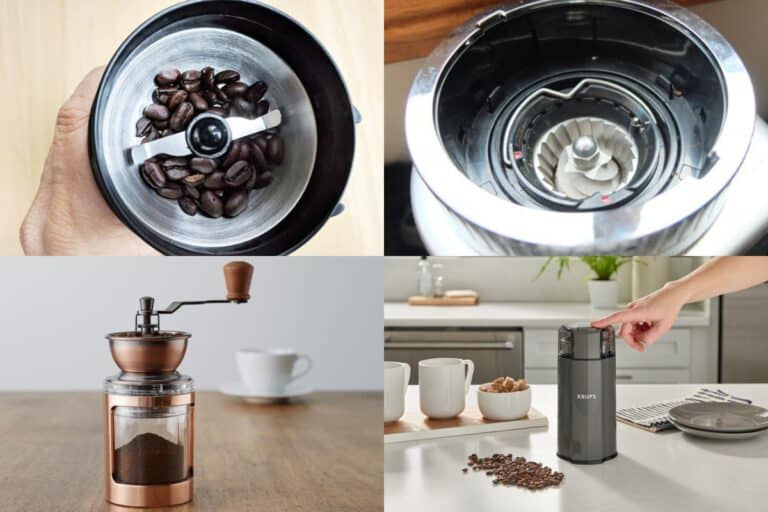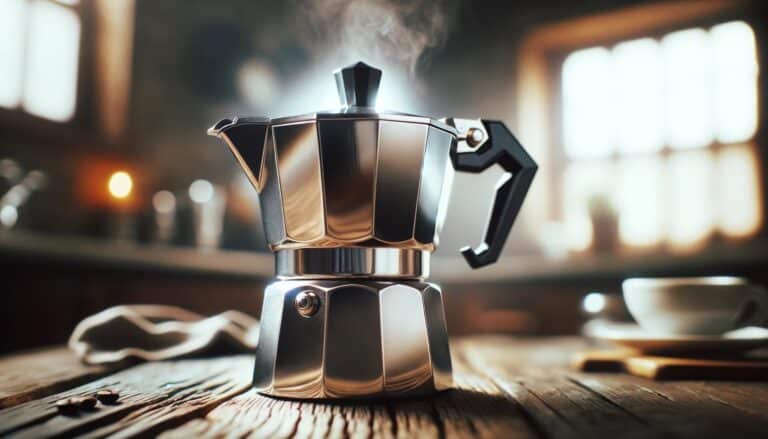In recent years, iced coffee has transcended its status as a seasonal beverage to become a year-round staple for coffee enthusiasts worldwide. Its soaring popularity is a testament to its versatility and the wide array of flavors and styles it offers. Iced coffee is no longer just a simple blend of coffee served over ice; it has evolved into a diverse category of its own, boasting an array of types each with unique preparation methods, flavor profiles, and cultural histories.
This article delves into the intriguing world of iced coffee, exploring its various forms that range from the classic iced coffee, a straightforward yet refreshing choice, to the more intricate and flavor-intense options like cold brew and nitro coffee. We will also look at iced espresso, a potent variant for those who prefer a stronger taste, and the Frappuccino, a modern, dessert-like adaptation that has gained a cult following. Additionally, we’ll explore the lesser-known but historically rich Mazagran, a type of iced coffee that offers a unique perspective on coffee consumption around the world.
Each of these types of iced coffee comes with its own history, brewing techniques, and special characteristics, offering a diverse palate for both coffee aficionados and casual drinkers alike. Through this exploration, we aim to not only enlighten our readers about the various options available but also to inspire them to experiment with these different styles in their own coffee journey. Join us as we embark on this flavorful exploration of iced coffee, a beverage that has captured the hearts and taste buds of millions around the globe.
Types of Iced Coffee
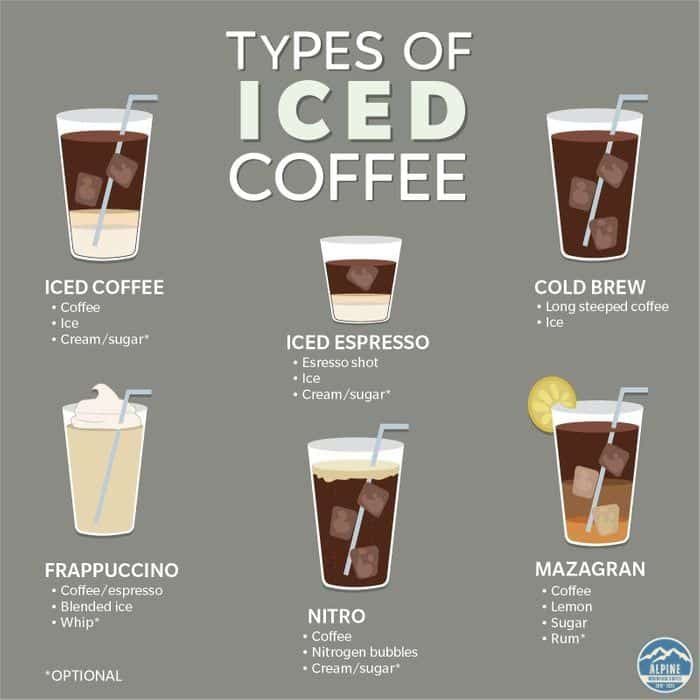
Iced Coffee
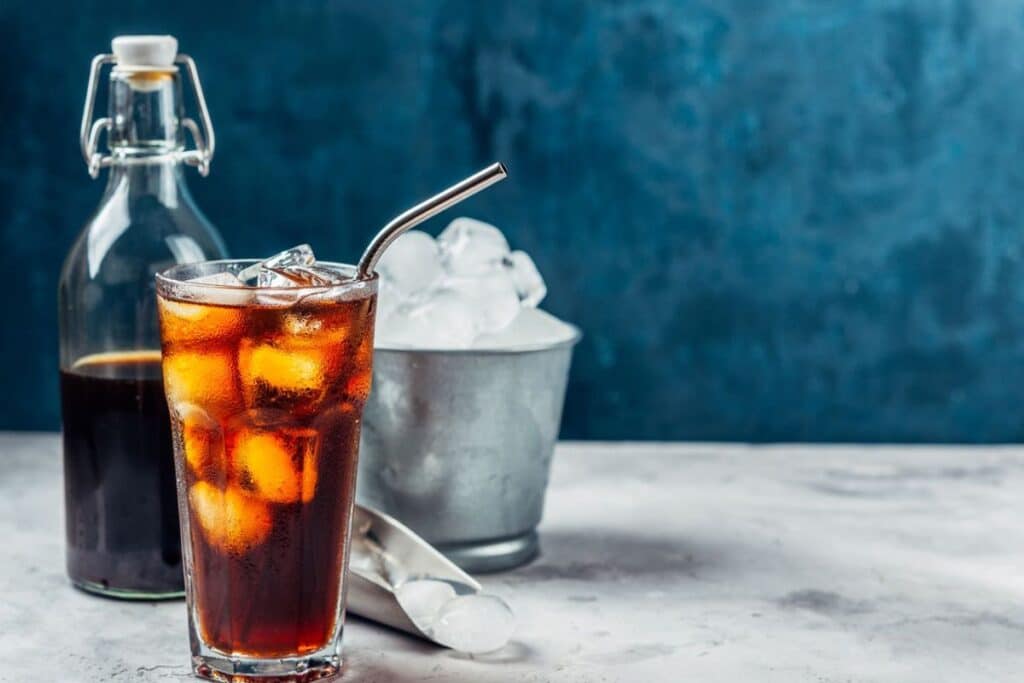
Definition and Brief History of Traditional Iced Coffee
Iced coffee, in its simplest form, is coffee that has been cooled down and served over ice. The concept of iced coffee dates back to the 19th century, with various forms appearing in different cultures. For instance, the French introduced “Mazagran,” a cold, sweetened coffee drink, in Algeria during the 1840s. The concept gradually spread across Europe and to America, where it was adapted into a more familiar form of iced coffee as we know it today. The rise of coffee shop culture in the late 20th and early 21st centuries propelled iced coffee to new heights of popularity, making it a staple in the menus of cafés worldwide.
Common Preparation Methods
The most straightforward method of preparing traditional iced coffee involves brewing coffee using standard methods, such as drip or espresso, and then cooling it down. This can be done by either letting the coffee sit until it reaches room temperature or by placing it in the refrigerator. Once cooled, the coffee is poured over ice and often sweetened or mixed with milk or cream. Another popular method is the “flash brewing” method, where hot coffee is brewed directly over ice, instantly chilling it and locking in flavor.
Popular Variations and Regional Differences
Iced coffee has taken on numerous forms and variations across the globe, reflecting regional tastes and traditions:
- Americano Iced Coffee: In the United States, iced coffee is often prepared as an iced Americano, made with espresso and water, then poured over ice.
- Australian Iced Coffee: In Australia, it’s common to find iced coffee served with ice cream and whipped cream, making it a more indulgent treat.
- Vietnamese Iced Coffee: Known as “cà phê đá,” this is a strong, sweet coffee made with dark roast Vietnamese-grown coffee and sweetened condensed milk, served over ice.
- Greek Frappé: Originating in Greece, this frothy iced coffee is made from instant coffee, water, sugar, and evaporated milk, shaken to a froth and served cold.
- Italian Affogato: While not a traditional iced coffee, the affogato is a beloved Italian dessert that involves pouring a shot of hot espresso over a scoop of vanilla gelato or ice cream, creating a rich and creamy coffee treat.
These variations highlight how iced coffee can be adapted to suit different palates and climates, making it a truly global beverage. Each regional take on iced coffee offers a unique window into the local coffee culture, inviting coffee lovers to explore a world of flavors beyond their own borders.
Iced Espresso

Explanation of What Makes Iced Espresso Distinct
Iced espresso stands out in the world of iced coffee for its concentrated flavor and robust character. Unlike traditional iced coffee, which is typically made from regular brewed coffee, iced espresso begins with espresso shots — a much stronger coffee base. Espresso is a highly concentrated coffee, brewed by forcing a small amount of hot water through finely-ground coffee beans. When served over ice, the intensity and richness of the espresso are preserved, offering a more potent coffee experience that is both refreshing and invigorating.
Brewing Techniques and Preferred Types of Espresso for This Method
Brewing a perfect shot of espresso is an art in itself. The key lies in using high-quality, freshly roasted beans, ground to a fine consistency. Espresso beans are generally roasted darker, which imparts a bold, rich flavor ideal for iced espresso.
- Brewing Process: The espresso is brewed using an espresso machine, which applies pressure to hot water as it passes through the coffee grounds. This process extracts the coffee’s oils, flavors, and aromas, resulting in a strong, full-bodied shot.
- Bean Selection: For iced espresso, beans with a robust and bold flavor profile are preferred. Single-origin beans from regions like Ethiopia or Colombia, or a well-balanced blend, are great choices. The roast level can vary from medium to dark, depending on personal preference.
Serving Suggestions and Popular Customizations
Iced espresso offers versatility in how it can be served and customized:
- Classic Iced Espresso: Served simply with ice, allowing the pure flavor of the espresso to shine through. This is perfect for those who appreciate the strong taste of coffee.
- Iced Espresso with Milk: Adding a splash of milk, cream, or a milk alternative can soften the intensity of the espresso, offering a smoother, creamier beverage.
- Flavored Iced Espresso: For those with a sweet tooth, flavored syrups such as vanilla, caramel, or hazelnut can be added. This customization is popular in many coffee shops and allows for a personalized coffee experience.
- Iced Espresso Tonic: A trendy and refreshing twist, this involves mixing the espresso over ice with tonic water, adding a unique effervescence and slight bitterness that complements the coffee.
- Iced Americano: For a less intense option, water is added to the espresso before it’s served over ice, diluting the strength slightly while maintaining the espresso’s essential characteristics.
Each serving style and customization of iced espresso caters to different tastes and preferences, making it a versatile choice for a wide range of coffee enthusiasts. Whether enjoyed in its pure form or customized to one’s liking, iced espresso remains a testament to the rich and complex world of coffee.
Cold Brew
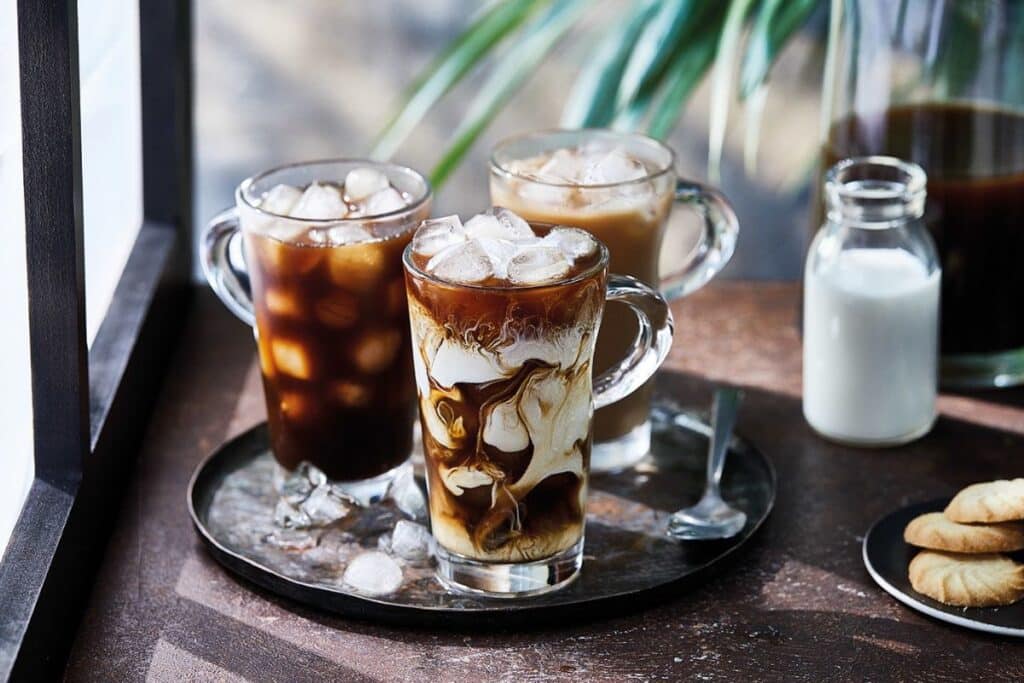
The Process of Making Cold Brew and How It Differs from Other Methods
Cold brew coffee is made by steeping coarse-ground coffee beans in cold water for an extended period, typically 12 to 24 hours. This method is fundamentally different from traditional coffee brewing techniques, which usually involve hot water to extract flavor and caffeine. In cold brewing, time replaces heat. The long steeping process in cold water extracts a different chemical profile from the beans compared to hot brewing methods. This results in a coffee concentrate that can be diluted with water or milk and served over ice.
Discussion of the Unique Flavor Profile of Cold Brew
Cold brew is renowned for its smooth, mellow flavor profile. The cold steeping process reduces the extraction of certain compounds, such as acids and oils, that are more soluble in hot water. This leads to a beverage that is typically less acidic and bitter than hot-brewed coffee or iced coffee made from hot-brewed coffee. Cold brew coffee often has a natural sweetness, with flavor notes that can range from chocolatey and nutty to fruity and floral, depending on the beans used.
Tips for Brewing Cold Brew at Home
- Bean Selection and Grind Size: Start with high-quality, whole beans. The grind should be coarse, similar to that used for a French press. Finer grinds can result in over-extraction and a gritty texture.
- Coffee-to-Water Ratio: A common starting point is a 1:8 coffee-to-water ratio, but this can be adjusted based on personal preference.
- Steeping Time and Temperature: Steep the coffee grounds in cold or room temperature water for 12 to 24 hours. The longer the steeping time, the stronger the concentrate. The brewing can be done in the refrigerator or at room temperature.
- Straining: After steeping, strain the coffee to remove the grounds. A fine-mesh sieve, cheesecloth, or a dedicated cold brew coffee maker can be used for this.
- Serving: The concentrate can be diluted with water, milk, or a milk alternative. It can be customized with sweeteners, flavored syrups, or spices as desired.
- Storage: Cold brew concentrate can be stored in the refrigerator for up to two weeks, maintaining its flavor and freshness.
Popular Commercial Options
For those who prefer convenience, there are numerous commercial cold brew options available:
- Ready-to-Drink Bottles and Cans: Many coffee brands offer cold brew in ready-to-drink formats, convenient for on-the-go consumption.
- Concentrates: Some companies sell cold brew concentrate, which can be diluted and customized at home.
- Coffee Shop Offerings: Most coffee shops now offer cold brew coffee, often with a variety of customizations like flavored syrups, creamers, and milk alternatives.
- Subscription Services: For regular cold brew drinkers, some brands offer subscription services where cold brew concentrates or ready-to-drink bottles are delivered regularly.
Cold brew coffee’s popularity continues to grow, thanks to its unique flavor profile and versatility. Whether brewed at home or enjoyed from a commercial product, cold brew offers a refreshing and distinct coffee experience.
Frappuccino

Origin of the Frappuccino and Its Evolution
The Frappuccino, a trademarked brand of the Starbucks Corporation, is a line of iced, blended coffee drinks that has become synonymous with modern coffee culture. Its origin traces back to the early 1990s when a Massachusetts coffee shop, The Coffee Connection, created a blended drink named the “Frappuccino.” After Starbucks acquired The Coffee Connection in 1994, they adopted and trademarked the Frappuccino name and started rolling out their version of the drink. This Starbucks-branded Frappuccino quickly gained popularity, leading to an explosion of varieties and becoming a cultural phenomenon.
Over the years, the Frappuccino has evolved significantly. From its initial version as a blended coffee drink, it has expanded to include a plethora of flavors, some coffee-based and others cream-based, catering to a wide range of tastes and preferences.
Description of Typical Ingredients and Variations
The basic Frappuccino typically consists of coffee or another base (like a cream blend for non-coffee variants), a sweetener, milk, and ice, all blended to a smooth, slushy consistency. It’s often topped with whipped cream and additional flavorings or syrups.
Variations include:
- Coffee-Based: These include flavors like mocha, caramel, or vanilla, with a coffee base.
- Cream-Based: These are non-coffee options, like the Strawberries and Cream Frappuccino, and are more like milkshakes.
- Seasonal and Limited Editions: Starbucks often introduces special flavors for limited times, often aligning with seasons or holidays, like the Pumpkin Spice Frappuccino.
- Customizations: Customers can customize their Frappuccinos with various syrups, types of milk, and add-ins like chocolate chips or flavored drizzles.
The Cultural Impact and Popularity of Frappuccino
The Frappuccino has had a significant impact on coffee and popular culture:
- Trendsetting in Coffee Shops: Its popularity spurred other coffee chains and independent cafes to create their versions of blended iced coffee drinks.
- Marketing and Social Media: The Frappuccino became a trendsetter on social media, with new flavors often becoming the subject of discussion and sharing.
- Influence on Consumer Behavior: The introduction of Frappuccino and its subsequent variations played a significant role in attracting a younger demographic to coffee shops, expanding the coffee-drinking market.
- Lifestyle Symbol: The drink has come to be associated with modern, urban lifestyles, often seen as a fashionable accessory in the hands of celebrities and influencers.
In essence, the Frappuccino is not just a drink; it’s a cultural icon that represents innovation, customization, and the modern coffee experience. Its ability to adapt, evolve, and stay relevant has made it a staple in the coffee industry and a beloved treat for coffee enthusiasts around the world.
Nitro Coffee

Introduction to Nitro Coffee and Its Unique Characteristics
Nitro coffee is a relatively recent innovation in the world of coffee beverages, known for its smooth texture and rich flavor. Introduced in the 2010s, Nitro coffee is cold brew coffee infused with nitrogen gas, served on tap like a beer. The introduction of nitrogen creates a creamy, frothy top, similar to the head of a stout beer, and gives the coffee a silky mouthfeel. Unlike traditional iced coffees or cold brews, Nitro coffee is typically served without ice, as the chilling and nitro infusion processes eliminate the need for it.
The Science Behind Nitrogen Infusion and Its Effect on Flavor and Texture
The infusion of nitrogen has a profound impact on the coffee’s texture and flavor. Nitrogen gas doesn’t easily dissolve in water, which leads to the formation of tiny bubbles in the coffee when it’s served. This results in a cascading effect, creating a rich, creamy head on top of the coffee.
The nitrogen infusion also affects the flavor of the coffee. It tends to reduce the perceived acidity of the coffee, making the drink smoother and less bitter than its non-nitro counterparts. This smoother profile often highlights the natural sweetness and complex flavors of the coffee beans, making it appealing even to those who might not usually enjoy black coffee.
Availability and How to Enjoy Nitro Coffee
Nitro coffee has become increasingly available in a variety of settings:
- Coffee Shops: Many specialty coffee shops and chains now offer Nitro coffee on tap.
- Canned Versions: For at-home consumption, canned Nitro coffees have become available in many grocery stores and online. These are often ready-to-drink and convenient.
- Home Brewing Kits: For the avid coffee enthusiast, home Nitro coffee kits are available, allowing for the creation of Nitro coffee in a home environment.
When it comes to enjoying Nitro coffee, the key is to appreciate its unique texture and flavor profile. It’s typically served plain, without milk or sweeteners, to allow the creamy texture and complex flavors to come through. The best way to enjoy it is fresh from the tap (or can), at a cool but not overly cold temperature, which allows its distinctive characteristics to shine.
The introduction and rise of Nitro coffee in the coffee scene have added an exciting and innovative dimension to the world of coffee, offering a unique experience that differs markedly from traditional coffee drinks. Its popularity continues to grow, appealing to coffee lovers who are looking for something smooth, rich, and visually appealing.
Mazagran

Historical Background of Mazagran
Mazagran is a unique cold coffee drink that blends the worlds of coffee and tea. Its origins trace back to the 19th century in Algeria. The story goes that during the French occupation, soldiers stationed at the Mazagran fortress in Algeria concocted a cold, sweetened coffee beverage to combat the heat. This drink, initially made with coffee syrup and water, was later adapted in France, where it was served with a shot of rum.
Mazagran is considered one of the earliest recorded cold coffee beverages and served as a precursor to many of the iced coffee drinks we see today. Its evolution and journey from Algeria to Europe mark an important chapter in the history of coffee.
Traditional Preparation Methods and Ingredients
The traditional Mazagran is a simple yet refreshing drink. The original Algerian version was likely made with coffee syrup and water, while the European adaptations included a shot of rum and sometimes lemon.
To make a classic Mazagran:
- Brew a strong coffee, often using a dark roast for a more robust flavor.
- Let the coffee cool to room temperature or chill it in the refrigerator.
- In a tall glass, mix the chilled coffee with a sweetener like sugar syrup.
- Add a splash of rum (optional, more common in the European version).
- Serve over ice, with a squeeze of lemon for a refreshing twist.
Modern Interpretations and Where to Find It
Today, Mazagran is not as widely known or available as other coffee drinks, but it has inspired modern variations and can still be found in some coffee shops, particularly those specializing in historic or global coffee drinks.
Modern interpretations might include:
- Using espresso instead of regular coffee for a stronger flavor base.
- Adding lemonade or sparkling water for a fizzy, refreshing element.
- Experimenting with different types of sweeteners or flavored syrups.
In Portugal, a variation of Mazagran, known as “Mazagran Lisboeta,” is popular. This version typically includes lemon, mint, and rum, offering a distinctly Portuguese twist on the original.
Mazagran, with its intriguing history and unique flavor profile, offers a glimpse into the early days of cold coffee beverages. While not as commonly found as other iced coffees, it remains a delightful and historic drink, worth exploring for those interested in the origins and evolution of coffee culture.
Conclusion
In this exploration of the diverse and captivating world of iced coffee, we have journeyed through a variety of styles, each with its unique history, preparation methods, and flavor profiles. From the classic and straightforward iced coffee, revered for its refreshing simplicity, to the robust and concentrated iced espresso, ideal for those seeking a more intense coffee experience. We delved into the smooth and mellow world of cold brew, a method that highlights the nuanced flavors of coffee, and the Frappuccino, a modern, dessert-like concoction that has become a cultural icon in its own right. The innovative Nitro coffee introduced us to a creamy, stout-like experience, pushing the boundaries of traditional coffee textures. And finally, we touched upon the historical Mazagran, a testament to the long-standing global love affair with iced coffee.
Each of these iced coffee types offers a unique window into the vast and varied landscape of coffee. They reflect not just different tastes but also different cultures, traditions, and innovations in the world of coffee brewing. This journey through the various styles of iced coffee reveals the beverage’s remarkable adaptability and its ability to continually evolve and reinvent itself.
As we conclude, I encourage you, the reader, to explore and experiment with these different styles of iced coffee. Whether you prefer your coffee strong and black, sweet and creamy, or infused with unique flavors, there is an iced coffee out there for you. The world of iced coffee is as diverse as it is delightful, offering endless possibilities for enjoyment and exploration. So, grab a glass, pick a style, and dive into the rich, refreshing, and ever-surprising world of iced coffee.
